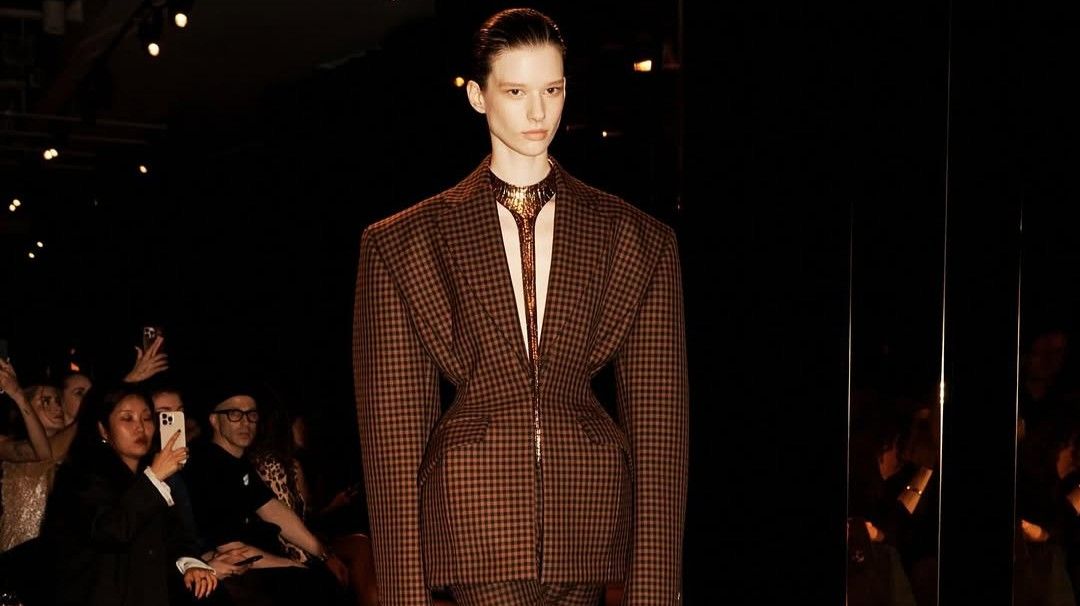
The recent the Schiaparelli show in Paris showcased designs with bigger shoulders, as well as neoprene padding at the hips.
Last month, I was standing backstage at the Schiaparelli show in Paris talking to designer Daniel Roseberry about his collection and the way he had used trompe l’oeil – bigger shoulders, neoprene padding at the hips – to create an hourglass figure.
“Like this?” I asked, pointing to a model in a gown accessorised with what resembled shelflike hip bones.
“Oh, well, not that one,” Roseberry said. “Those are actually her hips.”
Her bones were more than prominent enough, all on their own.
Of all the trends at the Autumn/Winter 2025 runway shows, including the uptick in fur (or fur-alike) clothing, the rise of clothing with built-in power curves and the preponderance of black leather, the single most ubiquitous one was the worst: the erosion of size inclusivity.
Ironically, as fashion embraces (and creates) faux womanly figures by design, the actual bodies inside the clothes are shrinking.
After reaching a peak in 2021, when Paloma Elsesser became the first plus-size model to appear on the cover of US Vogue, body diversity has taken a clear downward trajectory, decreasing pretty much every season.
“The pendulum went one way, and now it’s swinging full force the other way,” said David Bonnouvrier, a founder of DNA Model Management.
According to Vogue Business’ size inclusivity report for the fall season of this year, of 8,703 looks in 198 shows and presentations, only 2% were midsize (defined as US size 6-12) and only 0.3% were plus size (plus-size and midsize models are also known as “curve models”).
This was worse than the representation in the spring shows, which took place in September and October and included 0.8% plus-size looks and 4% midsize.
Indeed, data from Tagwalk, a fashion search engine, reveals that in the last show season, 16% fewer collections included even one curve model compared with the preceding season.
Read more: Lots of fur and leather, big shoulders: Key trends as seen at Paris Fashion Week
Of the 20 most viewed shows, only four included three such models: Hermes (out of 61 total looks), Givenchy (52), Coach (45) and Marni (41). Three!
“Change starts from the top, and the top is the top 20 most viewed and most searched brands,” said Alexandra Van Houtte, founder of TagWalk.
Where they lead, others follow. And apparently, this time it was backward.
Case in point: Nina Ricci, a label that under designer Harris Reed has been known for its inclusivity, featured only one midsize model – out of 38.
By contrast, Reed’s debut Nina Ricci show, in March 2023, opened with Precious Lee, a plus-size model, and included three more plus-size women in the show.
Asked about the change, a spokesperson for Nina Ricci said that competition for the limited number of curve models meant that the label wasn’t able to book them early enough to allow runway samples to be tailored to their bodies.
Nonetheless, she said, size diversity “continues to be an important subject”.
The issue is not simply that there are fewer curve models on the runway; the thin models seem to be getting thinner.
Even in a world that has long prized the idea of bodies as coat hangers, there were more visible rib cages, jutting collarbones and daisy chains of vertebrae than have been seen since the concept of body mass index and model health was introduced by the Council of Fashion Designers of America in 2012.
Given the documented connection between social media and eating disorders, especially among young people – and the way runway shows have become a mass form of public entertainment – such images have potentially dangerous repercussions.
Hillary Taymour, founder and designer of Collina Strada, one of the few labels in New York to include plus size as well as midsize models in its shows (having done so since its first show, in 2017), blamed Ozempic and other weight-loss drugs for the phenomenon.
“All the plus-size girls went to midsize because of Ozempic, and all the midsize girls went to standard size,” Taymour said.
“Everyone’s on it. It’s a drug that has created a skinnier industry and a new trend that skinnier and skinnier is better.”
It is true that the Food and Drug Administration’s approval of Wegovy for weight loss in 2021 coincided with the shrinking runway trend.
However, Bonnouvrier said he believed something deeper was going on – that the swing away from body diversity was part of a general swing away from social progressivism.
“As much as anything, this is a cultural conversation,” Bonnouvrier said.
With respect to model inclusivity, he said, brands are walking away because of what is going on in the US.
Peer pressure to diversify the runway in the wake of the #MeToo and Black Lives Matter movements led to a noticeable shift in conceptions of beauty, Bonnouvrier said.
But with diversity, equity and inclusion now under scrutiny as part of US president Donald Trump's administration’s war on wokeness, its fashion expression, including diversity of size, is under pressure.
A retreat to the most conservative and traditional approach for showcasing clothes means a retreat to old-fashioned stereotypes of beauty.
And that generally translates to homogenous, largely white and thin models, despite the fact that such body types are not representative of the fashion-buying population at large.
Read more: On Sarah Burton's new vision for Givenchy: Can she reinvent the fashion house?
As Taymour said, there’s a good business case to be made for demonstrating clearly that you “relate to all types of your customer base”, including all sizes.
Sarah Burton, the new creative director of Givenchy and the former creative director of Alexander McQueen, said much the same, noting that she wanted Givenchy “to celebrate the multiplicity, beauty and strength of womanhood, free of narrow definitions of how we should look or see ourselves”.
Yet, the trend continues to move in the opposite direction.
Bonnouvrier does not expect the trend to change anytime soon.
“We feel like the door is closing, slowly but surely,” he said. – Vanessa Friedman/©2025 The New York Times Company
This article originally appeared in The New York Times.









































